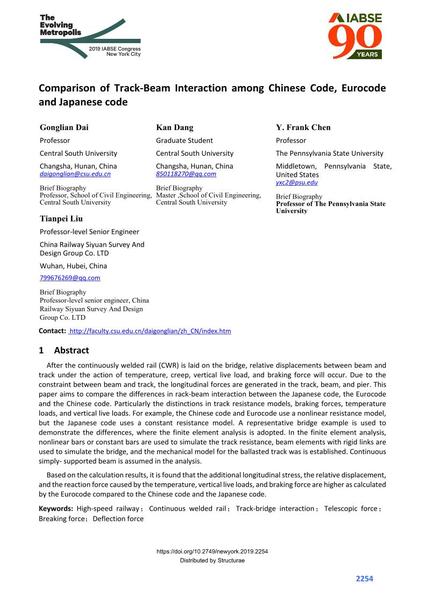Comparison of Track-Beam Interaction among Chinese Code, Eurocode and Japanese code

|
|
|||||||||||
Détails bibliographiques
| Auteur(s): |
Gonglian Dai
(Central South University, Changsha, Hunan, China)
Kan Dang (Central South University, Changsha, Hunan, China) Y. Frank Chen (The Pennsylvania State University) Tianpei Liu (China Railway Siyuan Survey and Design Group Co. LTD) |
||||
|---|---|---|---|---|---|
| Médium: | papier de conférence | ||||
| Langue(s): | anglais | ||||
| Conférence: | IABSE Congress: The Evolving Metropolis, New York, NY, USA, 4-6 September 2019 | ||||
| Publié dans: | The Evolving Metropolis | ||||
|
|||||
| Page(s): | 2254-2261 | ||||
| Nombre total de pages (du PDF): | 8 | ||||
| DOI: | 10.2749/newyork.2019.2254 | ||||
| Abstrait: |
After the continuously welded rail (CWR) is laid on the bridge, relative displacements between beam and track under the action of temperature, creep, vertical live load, and braking force will occur. Due to the constraint between beam and track, the longitudinal forces are generated in the track, beam, and pier. This paper aims to compare the differences in rack-beam interaction between the Japanese code, the Eurocode and the Chinese code. Particularly the distinctions in track resistance models, braking forces, temperature loads, and vertical live loads. For example, the Chinese code and Eurocode use a nonlinear resistance model, but the Japanese code uses a constant resistance model. A representative bridge example is used to demonstrate the differences, where the finite element analysis is adopted. In the finite element analysis, nonlinear bars or constant bars are used to simulate the track resistance, beam elements with rigid links are used to simulate the bridge, and the mechanical model for the ballasted track was is established. Continuous simply- supported beam is assumed in the analysis. Based on the calculation results, it is found that the additional longitudinal stress, the relative displacement, and the reaction force caused by the temperature, vertical live loads, and braking force are higher as calculated by the Eurocode compared to the Chinese code and the Japanese code. |
||||
